Imaging evaluation of dogs and cats with Dysphagia
- PMID: 23762579
- PMCID: PMC3671744
- DOI: 10.5402/2012/238505
Imaging evaluation of dogs and cats with Dysphagia
Abstract
The current literature is reviewed in this paper regarding the application of diagnostic imaging in the evaluation of swallowing disorders of the dog. The applications of radiography, contrast radiography, and contrast videofluoroscopy are discussed with pertinent case examples provided for emphasis. The indications for image-guided interventions are also described.
Figures
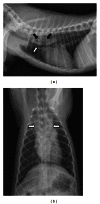
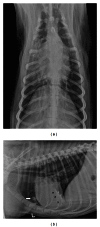
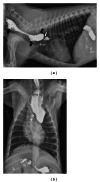
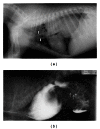

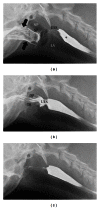
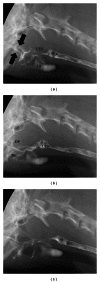




Similar articles
-
Diagnostic outcome of contrast videofluoroscopic swallowing studies in 216 dysphagic dogs.Vet Radiol Ultrasound. 2017 Jul;58(4):373-380. doi: 10.1111/vru.12493. Epub 2017 Mar 23. Vet Radiol Ultrasound. 2017. PMID: 28337826
-
Videofluoroscopic Evaluation of the Pharynx and Upper Esophageal Sphincter in the Dog: A Systematic Review of the Literature.Front Vet Sci. 2019 Apr 24;6:117. doi: 10.3389/fvets.2019.00117. eCollection 2019. Front Vet Sci. 2019. PMID: 31069238 Free PMC article.
-
Contrast videofluoroscopic assessment of dysphagic cats.Vet Radiol Ultrasound. 2014 Sep-Oct;55(5):465-71. doi: 10.1111/vru.12150. Epub 2014 Feb 18. Vet Radiol Ultrasound. 2014. PMID: 24547892
-
Combined videofluoroscopy and manometry in the diagnosis of oropharyngeal dysphagia: examination technique and preliminary experience.Radiol Med. 2008 Sep;113(6):923-40. doi: 10.1007/s11547-008-0290-5. Epub 2008 Jul 24. Radiol Med. 2008. PMID: 18587532 English, Italian.
-
Image-guided interventional procedures in the dog and cat.Vet J. 2011 Mar;187(3):297-303. doi: 10.1016/j.tvjl.2009.12.011. Epub 2010 Jan 13. Vet J. 2011. PMID: 20074984 Review.
Cited by
-
Standardization of a Videofluoroscopic Swallow Study Protocol to Investigate Dysphagia in Dogs.J Vet Intern Med. 2017 Mar;31(2):383-393. doi: 10.1111/jvim.14676. Epub 2017 Feb 27. J Vet Intern Med. 2017. PMID: 28240398 Free PMC article.
-
Use of a videofluoroscopic feeding evaluation to guide management of dogs with congenital idiopathic megaoesophagus.Vet Med Sci. 2022 Jul;8(4):1434-1442. doi: 10.1002/vms3.821. Epub 2022 Apr 27. Vet Med Sci. 2022. PMID: 35476311 Free PMC article.
-
Videofluoroscopic swallow study features of lower esophageal sphincter achalasia-like syndrome in dogs.J Vet Intern Med. 2019 Sep;33(5):1954-1963. doi: 10.1111/jvim.15578. Epub 2019 Aug 5. J Vet Intern Med. 2019. PMID: 31381208 Free PMC article.
-
Videofluoroscopic swallow study abnormalities identify aerodigestive disorders in dogs with respiratory disease versus healthy controls.J Vet Intern Med. 2023 May-Jun;37(3):1166-1178. doi: 10.1111/jvim.16685. Epub 2023 Mar 23. J Vet Intern Med. 2023. PMID: 36951400 Free PMC article.
-
Retrospective analysis of esophageal imaging features in brachycephalic versus non-brachycephalic dogs based on videofluoroscopic swallowing studies.J Vet Intern Med. 2019 Jul;33(4):1740-1746. doi: 10.1111/jvim.15547. Epub 2019 Jun 19. J Vet Intern Med. 2019. PMID: 31218762 Free PMC article.
References
-
- Watrous BJ. Clinical presentation and diagnosis of dysphagia. Veterinary Clinics of North America—Small Animal Practice. 1983;13(3):437–459. - PubMed
-
- Watrous BJ, Suter PF. Normal swallowing in the dog: a cineradiographic study. Veterinary Radiology and Ultrasound. 1979;20(3–6):99–109.
-
- Warnock JJ, Marks SL, Pollard R, Kyles AE, Davidson A. Surgical management of cricopharyngeal dysphagia in dogs: 14 cases (1989–2001) Journal of the American Veterinary Medical Association. 2003;223(10):1462–1468. - PubMed
-
- Watrous BJ. The esophagus. In: Thrall DE, editor. Veterinary Diagnostic Radiology. 5th edition. St. Louis, Mo, USA: Saunders Elsevier; 2007. pp. 495–511.
-
- Gengler W. Gagging. In: Ettinger SJ, Feldman EC, editors. The Textbook of Veterinary Internal Medicine. St Louis, Mo, USA: Saunders Elsevier; 2010. pp. 189–191.
LinkOut - more resources
Full Text Sources
Miscellaneous
